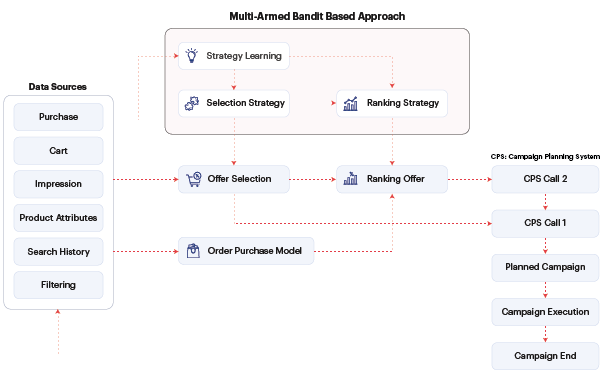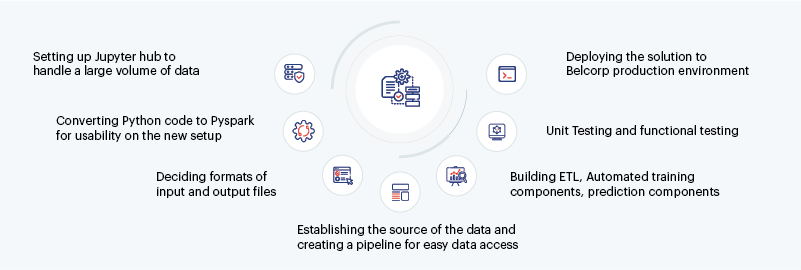Increased profitability & customer lifetime value through personalization
Reading Time: 6 minutes

Product recommendations based on personal preferences have taken customer-centricity to a whole new level. Advances in technologies such as data analytics and artificial intelligence are allowing marketers to predict customer needs better and create personalized experiences, in turn, increasing the conversion rates, revenue, average order value, and customer lifetime value.
The customer journey in today’s world is more than just their visit to physical stores or e-commerce websites. It is now focusing on staying relevant in the customer’s life at various touchpoints.
With increased competition and the availability of platforms for customers to share real-time feedback about their experiences, it has become quite imperative to keep customer preferences as the top priority. In fact, more than 22% of customers expect personalized products or services from companies and are willing to share their data with companies.
Personalization not only increases customer satisfaction and brand loyalty but has several long-term benefits such as more sales conversion and reduction in marketing costs. A McKinsey study reveals that personalization can lead to up to 20% higher customer satisfaction and increase sales conversion by up to 15%.
Personalized recommendations are built on user data such as their interests, past purchases, search history, and more to have a complete understanding of customers and make useful predictions about them. It is therefore important to understand customer engagement from every point of their journey to carry powerful analyses and build offerings based on their preferences.
Despite all the benefits personalization has to offer, many companies feel that they are not on the right track while implementing personalization strategies and becoming customer-centric. Reports suggest that offering customized products and services has led to an increase in revenue as well as better return on marketing spends. Investing in customer data and analytics foundations, and understanding their behavioral patterns and customer propensity has many benefits in store
In this blog, we will discuss how a major cosmetics company in Latin America, operating in over 11 countries implemented personalized recommendations practices to maximize the average sales per order, improve conversion rate and customer lifetime value. We developed a personalized digital recommender system for their recently built website (which contributes to ~10% of overall sales).
Existing Challenges
The client operated under the direct sales model and sold predominantly through physical magazines and catalogs in 4 countries with around 10000+ products. Their products were sold through multiple campaigns across the year offering massive discounts to everyone rather than personalizing bespoke offers for better visibility among consultants. While the client built a basic recommendation system, they needed better ways to test and understand the personalization strategies. Some of the challenges they faced were:
- The existing system had a fixed set of business rules to determine the display rank of offers & promotions. It did not have a system to suggest cross-sell, up-sell, and similar products which mostly resulted in smaller order sizes per consultant as compared to the possible potential
- Needed better ways to test and understand the performance of personalization strategies
- It did not take into account business metrics such as customer lifetime value and the ratio of cost to sales
- The model couldn’t generate timely recommendations for larger markets with a high number of consultants and offers
The client was looking for better ways to test and understand the performance of personalization strategies and wanted a mechanism to improve their existing recommendation system to maximize profitability and revenue, increase the customer lifetime value, and maintain the cost-to-sales ratio.
Sigmoid’s Solution
Sigmoid developed an end-to-end Personalized Recommender System for the client to maximize the order value per consultant, boost profitability and identify strategies to up-sell and cross-sell products to increase the customer lifetime value of consultants.
Developing the ML-driven recommendation solution
Sigmoid used Multi-Armed Bandit (MAB), a Reinforcement Learning technique for generating personalized recommendations for digital subscribers based on customers’ purchase history. It identified different profiles of consultants and developed personalized strategies for each segment to reduce the learning rate from the initial strategy. It suggested a personalized offer ranking based on individual consultant profiles across 11 countries & 5 product categories.
The MAB solution also helped to learn from personalized recommendation strategies and select the best performing strategies for a specific user for future campaigns, based on real-campaign feedback for consultants. We further carried out a Market basket analysis for generating cross-sell and upsell offers for all consultants and created an architecture for dynamic reordering of offers based on shopping cart information.
In Phase 1, Sigmoid built an end-to-end system for generating recommendations to suggest which offer should be used at which order for a consultant in a country campaign. In Phase 2, we worked on improving the model created in Phase 1 by adding physical offers data and features to address offer cannibalization. We also added more strategies for different consultant profiles along with strategies for cross-selling and similar products.
In order to enable fast execution and time-based deliverables, the Sigmoid team used an agile framework where the baseline prediction model was created in the 1st sprint and improved upon in each sprint through feature engineering, feature selection, model tuning through grid search, and cross-validation across 14 weeks. Here is a brief of the solution architecture that Sigmoid implemented:


Productionizing the ML model
We also enabled system architecture for integration with the client’s environment. As a part of integration, migration, and deployment highlights, we helped them migrate from Python to Pyspark to leverage distributed parallel computing framework to handle larger data. We also ensured the on-time deployment of the entire solution for timely Go-Live of the overall campaign planning solution. The key steps in productionizing model were:
- Setting up Jyuptier hub to handle a large volume of data
- Converting Python code to Pyspark for usability on the new setup
- Deciding formats of input and output files
- Establishing the source of the data and creating a pipeline for easy data access
- Building ETL, Automated training components, prediction components
- Unit Testing and functional testing
- Deploying the solution to the client’s production environment
As a part of the measurement framework, we created a new mathematical measure to evaluate model performance without real-world deployment thereby minimizing the risk of exposure by ensuring that the model performance is at least as good as the existing system in the beginning. We also designed the test-control framework for A/B testing of the model in live campaigns. In order to have a more conclusive validation of the test results, we not only chose to compare the new solution with the older solution but also to a randomized offer ranking method.

Business Impact
Our experienced team of data scientists delivered the entire solution from PoC development to production in 16 weeks by effectively tracking milestone progress in weekly catchups and sprint reviews.
Sigmoid’s MAB solution resulted in increased sales of big-ticket items and drove up profitability by 8% and campaign revenues by 24%. The client achieved 21% better average sales per order as compared to the existing APD model and 24% over the random ranking model. We were successful in identifying the best mix of strategies for consultants by creating over 100 strategies for each consultant and country combination. This also accounted for more consultant profiles to be a part of the recommended solution.
Featured blogs
Subscribe to get latest insights
Talk to our experts
Get the best ROI with Sigmoid’s services in data engineering and AI
Featured blogs
Talk to our experts
Get the best ROI with Sigmoid’s services in data engineering and AI







